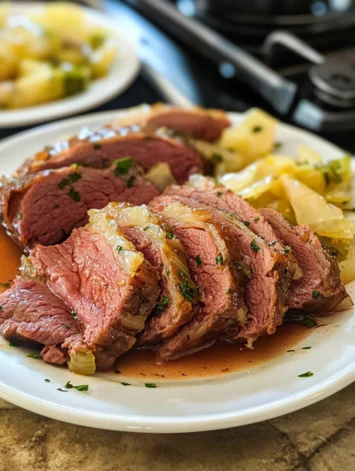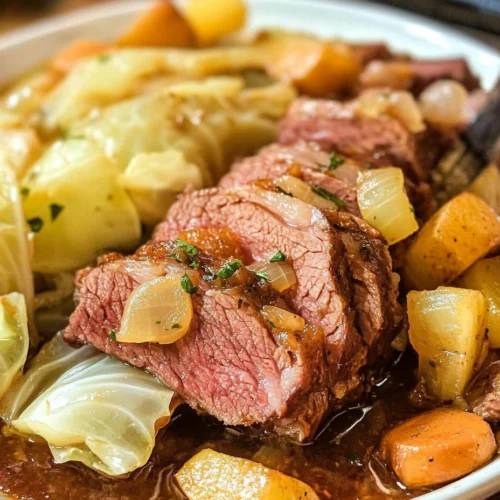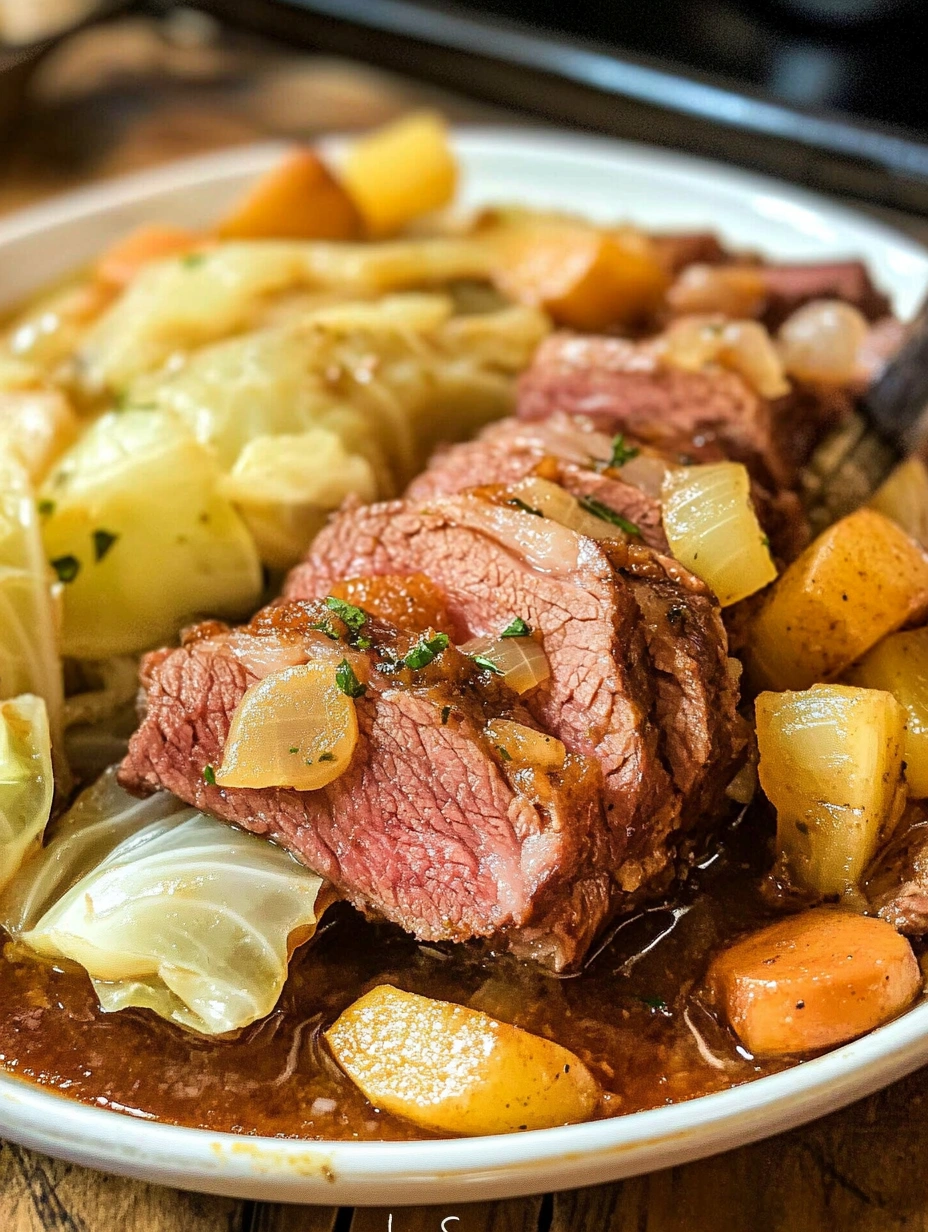When the smell of corned beef and cabbage fills the kitchen, it’s a special time. It brings back memories of St. Patrick’s Day with family and friends. Whether you’re an experienced cook or new to the kitchen, making this dish is comforting and nostalgic.
I once had trouble with my corned beef, but I’ve learned a lot over the years. I’d like to share these tips with you. This way, your corned beef and cabbage can become a beloved holiday tradition.

Key Takeaways
- Rinse the corned beef thoroughly to remove excess salt before cooking.
- Cook the corned beef at 350°F for 1 hour, then reduce to 325°F for an additional 3 hours.
- Sprinkle the spice packet over the beef before baking to enhance flavor.
- Use Yukon Gold or Red Potatoes as they hold up better during cooking.
- Sauté onions and cabbage in olive oil and butter for added flavor.
- Let the corned beef rest for 15 minutes before slicing to keep it juicy.
- Store leftovers in an airtight container for up to 4 days or freeze for 3-4 months.
How to Choose the Best Corned Beef Cut
Choosing the right corned beef is key for a great dish. Knowing the difference between flat and point cut briskets is important. This guide will help you pick the best one for your recipe.
Flat Cut vs. Point Cut Brisket
The flat cut brisket is leaner, making it easy to cook and slice. It’s perfect for a neat presentation. In contrast, the point cut brisket has more fat and flavor. Its shape holds juices well, making it tender and juicy.
Importance of Fat and Marbling

Fat and marbling are vital for great corned beef cuts. The fat in a point cut brisket adds flavor and keeps the meat moist. It’s best for slow-cooking, like braising or roasting.
Selecting Quality Meat
Choose corned beef that’s firm, not soft. A good brisket balances fat and lean meat. Opt for trusted brands for quality. Whether you prefer a flat cut brisket or a point cut brisket, the right choice will make your dish better.
Best Cooking Methods for Corned Beef
Whether you’re a seasoned chef or a home cook, learning how to cook corned beef is key. I’ll share the best techniques to fit your kitchen and schedule.
Slow Cooker vs. Oven
Slow cooker corned beef is perfect for busy days. It’s simple: just add the meat, water, and spices. After 8 to 10 hours, it’s tender and delicious. Add veggies like carrots and potatoes for a full meal.
Baking corned beef in the oven gives a crispy outside and juicy inside. It takes about 4.5 to 5 hours at 325°F. Use a roasting pan with a lid to keep it moist.

Boiling and Braising Techniques
Boiling corned beef is easy and efficient. It’s simmered in water with spices for hours. This method infuses flavors deeply into the meat.
Braising cooks the meat slowly in a small liquid. Use beer, water, or a mix for flavor. It takes about the same time as baking but tastes different.
“Set It and Forget It” Approach
The slow cooker method is perfect for minimal effort. It cooks the beef for 8 to 10 hours on low. This way, you get tender meat without much work.
Choosing the right method can make your corned beef dish amazing. Whether it’s slow cooker, braising, or baking, you’ll impress your family.
Enhancing Your Corned Beef and Cabbage Recipe
To make your corned beef and cabbage dish irresistible, focus on the details. We’ve got some tips to make your corned beef recipe even better. This way, every bite will be full of flavor and tender.
Vegetable Preparation Tips
Timing your vegetables right is key to a great corned beef and cabbage. Start with potatoes and carrots. Add them in the last 1-2 hours to avoid mushiness.
Cabbage needs special care. Cook the wedges for 30-60 minutes towards the end. Searing them in olive oil before cooking makes a big difference.
Adding Extra Flavor with Spices
To make your corned beef and cabbage even better, add different spices. Use the seasoning packet, but also add peppercorns, thyme, and garlic. These spices will make the flavor richer and pair well with the brisket.
Place the spices in a cheesecloth bundle or a tea infuser for easy removal. This trick will turn your corned beef into a dish to remember.
Cooking Times for Optimal Tenderness
For tender corned beef, slow cooking is the way to go. Use a slow cooker or oven for 6-7 hours. This method ensures the meat is tender and juicy.
Let the corned beef rest, covered loosely in foil, after baking. This step keeps the moisture in and improves the texture. Aim for an internal temperature of about 200 degrees Fahrenheit for the best results.
By following these tips, you’ll make your corned beef and cabbage dish even better. Focus on timing your vegetables, choosing the right spices for corned beef, and cooking it low and slow. This way, every bite will be a joy to eat.
Serving Suggestions and Sides
Planning your St. Patrick’s Day meal? Serve corned beef with tasty sides to make it a feast. While corned beef and cabbage is classic, adding different sides makes your meal special.
Try traditional Irish dishes like Irish soda bread. It’s crumbly and pairs well with corned beef. Colcannon, a mix of mashed potatoes and cabbage, is another great choice.
For something new, try citrus-roasted broccoli or garlic butter Swiss chard. Pan-fried okra adds a nice crunch.
Potatoes are a must-have, and you can prepare them many ways. Think mashed, roasted, or even twice-baked. Try crispy smashed potatoes with garlic cheese sauce or tangy balsamic potatoes for a twist.
Other veggies like Parmesan green beans, roasted carrots, and balsamic potatoes add color and nutrition. Root vegetables like beets or a mix of roasted roots add sweetness.
For big groups, air fryer Brussels sprouts are crispy and tasty. Use leftovers for Reuben sandwiches or corned beef hash to keep the party going.
No meal is complete without bread. Cheddar zucchini bread, soft biscuits, and homemade sauerkraut are great choices. And don’t forget a refreshing green beer, like Guinness, to enjoy with your meal.
With these ideas, serving corned beef becomes a fun and festive experience. Your meal will be filled with delicious sides that everyone will love.
Conclusion
Making the perfect corned beef and cabbage is all about paying attention to every detail. It starts with picking the right cut of meat and fresh veggies. Each choice makes the dish better. It might take some work, but the end result is worth it.
This meal is more than just food; it’s a way to celebrate St. Patrick’s Day with family. The dish not only tastes great but also fills your home with wonderful smells. It’s a time to share moments and make memories together.
The secret to a fantastic corned beef and cabbage is slow cooking, the right seasonings, and commitment. These things come together to make a dish that honors traditions and family cooking. So, get cooking and enjoy every delicious bite!
FAQ
What is the difference between flat cut and point cut brisket for corned beef?
The flat cut brisket is leaner and even, making it easy to slice and cook. The point cut is thicker and more flavorful. It has more fat and marbling, which makes it taste better when cooked.
Why is fat and marbling important in selecting corned beef?
Fat and marbling in meat melt during cooking. This adds flavor and keeps the meat moist.
How can I ensure I’m selecting quality corned beef?
Choose corned beef with a good balance of meat and fat. It should feel firm. Also, check the brand’s reputation for quality.
What are the best cooking methods for corned beef?
Slow cooking and baking are top choices. Slow cooking is easy. Baking or braising gives a crispy crust and keeps the inside juicy.
How does the “set it and forget it” approach work for corned beef?
A slow cooker lets you cook corned beef without watching it. It tenderizes over hours, making it easy.
How do boiling and braising affect corned beef?
Boiling is simple but needs watching. Braising in the oven makes the outside crispy and the inside tender.
What tips do you have for preparing vegetables for corned beef?
Add veggies like cabbage late in cooking. This keeps them crunchy and colorful. It also prevents them from getting soggy.
How can I add extra flavor to my corned beef and cabbage recipe?
Use spices like peppercorns, mustard seeds, and bay leaves. They add deep flavors that go well with the brisket.
What are the optimal cooking times for tender corned beef?
Cook it slow at a low temperature. Aim for an internal temperature of 200 degrees Fahrenheit. This breaks down the connective tissues.
What are some serving suggestions and sides for corned beef and cabbage?
Serve with Irish soda bread, roasted potatoes, and creamy horseradish sauce. Mustards or balsamic reduction can add flavor. Presenting it beautifully makes it a festive centerpiece.

Corned Beef and Cabbage Slow Cooker Recipe
Ingredients
- 3 to 4 pounds corned beef brisket uncooked with spice packet
- ▢1 onion
- ▢3 cloves garlic sliced
- ▢2 bay leaves
- ▢2 ½ to 3 cups water
- ▢2 pounds potatoes peeled* & quartered
- ▢2 large carrots chopped
- ▢1 small head green cabbage cut into wedges
Instructions
- Chop onion into large chunks and place in the bottom of a 6 qt slow cooker.
- Top with corned beef and seasoning packet.
- Pour water into slow cooker until it just about covers the corned beef. Add garlic and bay leaves.
- Cook on low 8-10 hours.
- After the initial 3 hours, add potatoes and carrots to the slow cooker.
- Two hours before serving, add cabbage wedges to the slow cooker.
- Remove corned beef from slow cooker and let rest 15 minutes before slicing. Serve with potatoes, carrots and cabbage.
Notes
Up to 2 cups of water can be replaced with beer if desired.
If your corned beef doesn’t have a spice packet, add a couple of tablespoons of pickling spices, a few peppercorns, and a bay leaf. Bundle them up in cheesecloth and add them to the slow cooker.
If using russet or baking potatoes, they should be peeled. If using thin skinned potatoes (red, Yukon gold), peeling is optional.
Once cooked corned beef should be tender (mine usually cooks closer to the 10 hour time). Appliances can vary, if your corned beef is not tender, it likely needs to cook longer.
It is essential to cut your corned beef across the grain.
You May Also Like
Source Links
https://www.spendwithpennies.com/corned-beef-and-cabbage-slow-cooker-recipe/
